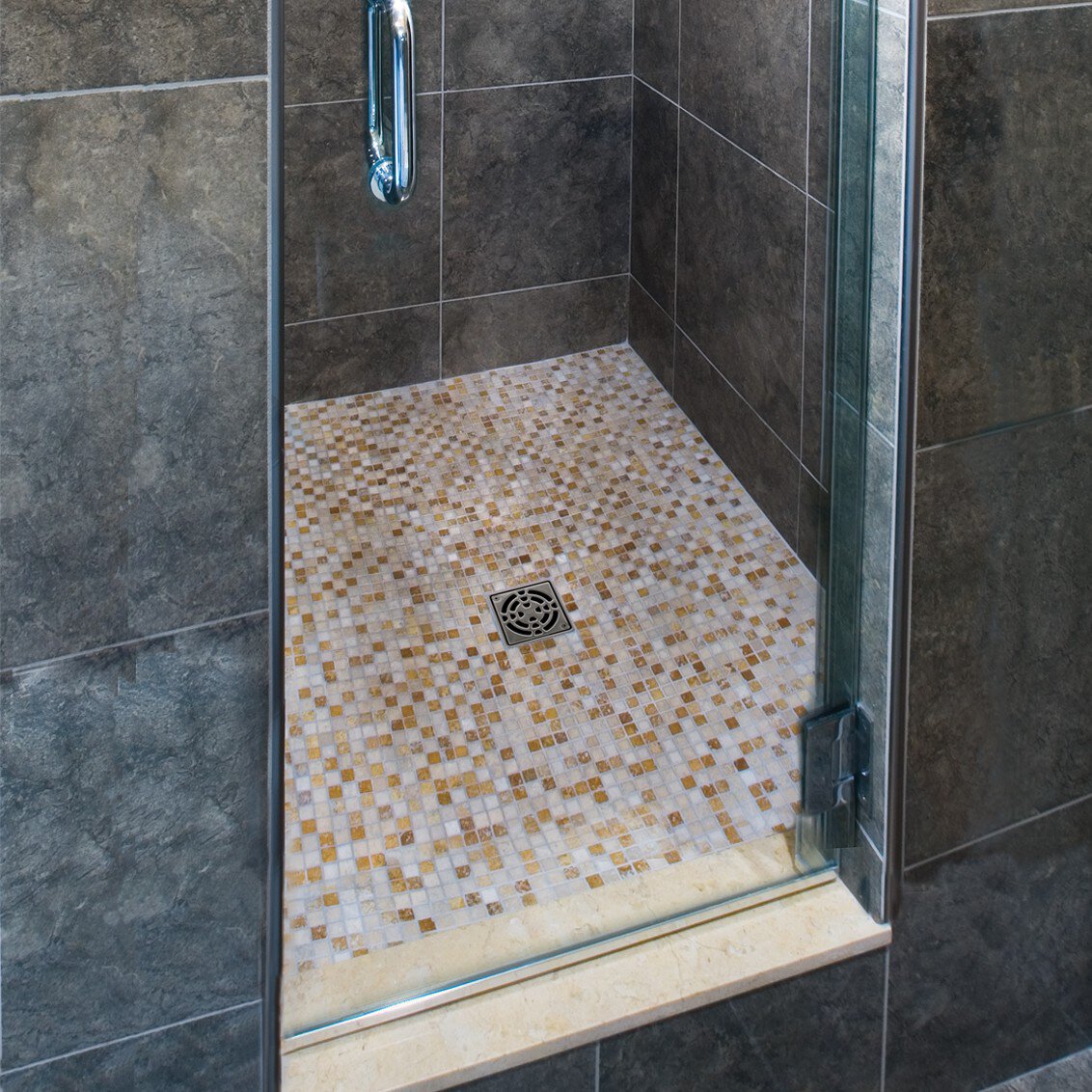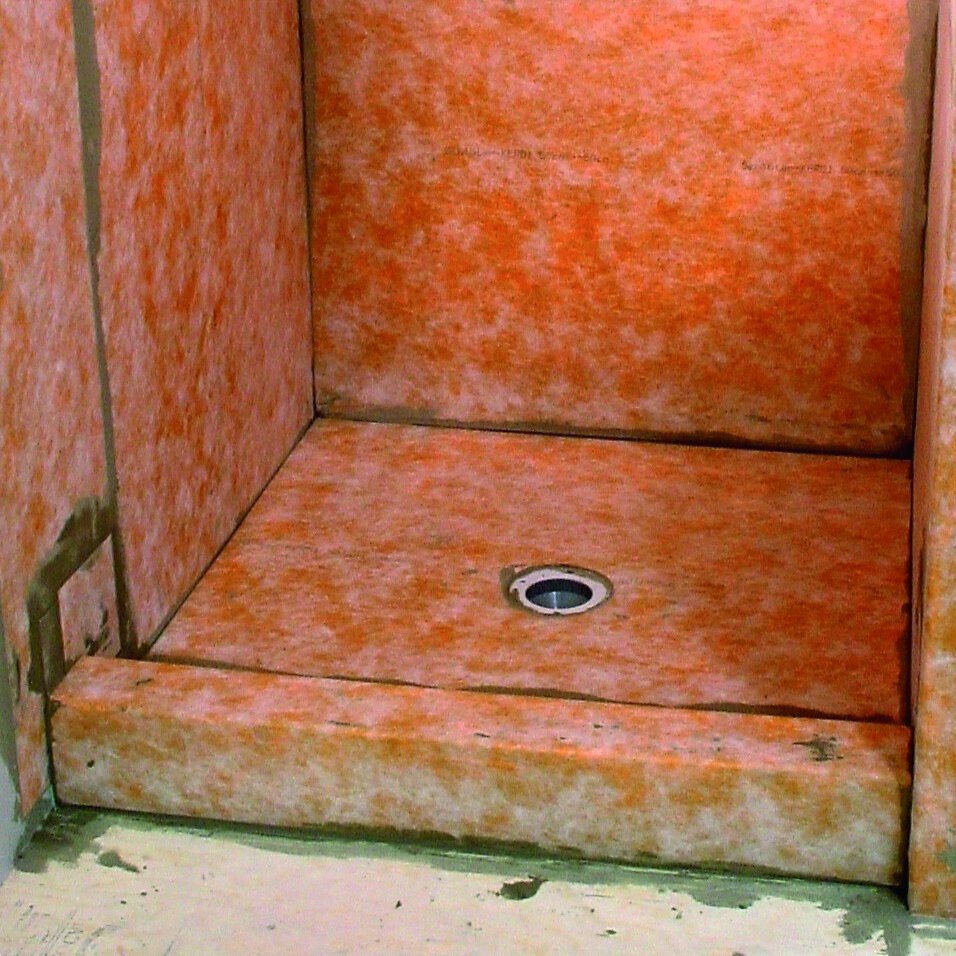Essential Water Management in Tiled Showers
By Sean Gerolimatos, Research and Development, Schluter Systems L.P.
For publication by Tile Letter Magazine

Tiled showers are beautiful, durable, and hygienic when designed and installed properly. Tile offers a myriad of design options that other assemblies simply can’t match. However, poor design and installation can result in leaks and mold growth, which may cause damage to the surrounding structure and lead to an unsanitary environment. This article will present the two primary methods for installing tiled showers, the traditional method and the bonded waterproof method, and explain how each functions to manage water and prevent leaks and mold growth.
Traditional Tiled Shower Assemblies: Water in/Water out Systems
The traditional method for installing tiled shower assemblies creates what can be described as a water in/ water out system. It begins with the installation of a mortar bed that is sloped to the weep holes in the drain. A waterproofing membrane, typically referred to as a pan liner, is subsequently placed over this "pre-slope" and clamped into the drain. Pan liners may consist of metals such as lead and copper or plastics such as polyvinyl chloride (PVC) and chlorinated polyethylene (CPE). Some regions of the country also employ hot mop systems that involve applying layers of asphalt and roofing felt to build up a pan liner. Pan liners are carried up to a height of at least 3" above the finished height of the curb, and must not be penetrated by any fasteners. Pan liners are not designed to allow for the direct application of ceramic or stone tile. Thus, a mortar bed must be installed to provide load distribution and a bonding surface for the floor tile. Crushed stone or tile is placed around the weep holes of the drain to prevent blockage before installing the mortar bed. Most wall assemblies incorporate 4-mil polyethylene or roofing felt placed behind the tile substrate (i.e., floated mortar or backerboard panels) and lapped over the pan liner.
Each component described above is essential to the function of the overall system. For example, a common error is to ignore the pre-slope installation and place the pan liner directly over the flat subfloor. Since the tile layer itself is not waterproof, moisture will infiltrate the mortar bed. If the pan liner is not placed on a slope, the system will not effectively drain the water to the weep holes in the drain, creating a permanently saturated mortar bed. This increases the potential for efflorescence and mold growth within the system. Another all too common mistake is to penetrate the pan liner by using nails to fasten backerboard panels to the curb. Even small penetrations in a pan liner can lead to large leaks and damage to the surrounding materials.
The Tile Council of North America (TCNA) Handbook for Ceramic Tile Installation includes various methods for the installation of tiled showers in the traditional manner (e.g., B414, B415, etc.) and serves as a valuable reference to the installer.

Bonded Waterproof Tiled Shower Assemblies: Sealed Systems
Around twenty years ago, manufacturers introduced bonded waterproof membranes, which are adhered to the substrate and allow for the direct application of tile. These membranes include sheet-applied products, which are bonded to the substrate with thin-set mortar or other adhesives, and trowel-applied products, which are spread over the substrate and allowed to dry/cure. Trowel-applied membranes may also incorporate reinforcing mesh at corners and joints, or over the entire surface. The minimum performance criteria for bonded waterproof membranes are established in the ANSI A118.10 standard.
The availability of bonded waterproof membranes has revolutionized tiled shower installation. These products allow the installer to produce a sealed system, in contrast to the water in/ water out system described previously. In general, the process begins with the installation of a sloped mortar base on the subfloor and solid backing on the walls. The bonded waterproof membrane is installed on top of the mortar bed and solid backing and tied into the drain, with tile installed over the membrane using thin-set mortar. The resulting assembly does not permit moisture penetration into the solid backing or mortar bed, allowing the assembly to dry completely between uses and eliminating the potential for mold growth in the system.

While traditional drains have been used in these assemblies, fundamentally these drains are not designed to integrate with bonded waterproof membranes. Traditional drains are designed to clamp to pan liners below the mortar bed, while bonded waterproof membranes are topically applied. A solution to this incompatibility came in the form of drains that feature integrated bonding flanges. These drains provide a large, fleece-covered contact area to allow for a watertight connection between the membrane and the top of the drain assembly.
Thus, the membrane is applied entirely at the surface, with all water directed into the top of the drain. Secondary drainage through the mortar bed to weep holes in a traditional drain is completely eliminated. Method B422 in the TCNA Handbook for Ceramic Tile Installation demonstrates the use of the integrated bonding flange.
Note Regarding Water Vapor
It is important to consider that water exists as both liquid and vapor in showers, and must be managed in both forms. The prime example of this is the steam shower. Steam showers that are not designed to manage water vapor have caused mold growth in wall cavities, rot in wood framing, and damage to moisture-sensitive wall coverings on the opposite side of the stud cavities. Specifiers and installers should be aware that the ANSI A118.10 standard for bonded waterproof membranes was developed to provide a framework for determining the suitability of these products to serve as barriers to positive liquid water migration only. As such, the standard does not include a minimum criterion to establish the ability of products to limit vapor transmission. Thus, simply selecting a membrane that meets the requirements of the ANSI A118.10 standard for a steam shower application is not enough. The ability of the product to limit vapor transmission must be considered as well. Water vapor permeance is a measure of how quickly water vapor is transmitted through a material and is determined according to the ASTM E96 Standard Test Method for Water Vapor Transmission of Materials. The higher the vapor permeance, the less effective a material is at slowing vapor transmission. Materials with a water vapor permeance of 1.0 perm or lower are generally considered to be vapor retarders and will manage vapor effectively in showers and steam showers. Manufacturers should be consulted regarding the water vapor permeance of their products to help determine suitability in specific applications, such as steam showers.
Tiled showers are beautiful, durable, and hygienic when designed and installed properly. By following the appropriate methods and paying close attention to detail, the installer can offer the owner the premium option for shower assemblies and help to grow the tile industry in general.